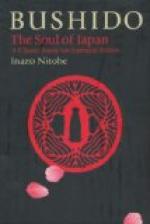Discipline in self-control can easily go too far. It can well repress the genial current of the soul. It can force pliant natures into distortions and monstrosities. It can beget bigotry, breed hypocrisy or hebetate affections. Be a virtue never so noble, it has its counterpart and counterfeit. We must recognize in each virtue its own positive excellence and follow its positive ideal, and the ideal of self-restraint is to keep our mind level—as our expression is—or, to borrow a Greek term, attain the state of euthymia, which Democritus called the highest good.
The acme of self-control is reached and best illustrated in the first of the two institutions which we shall now bring to view; namely,
THE INSTITUTIONS OF SUICIDE AND REDRESS,
of which (the former known as hara-kiri and the latter as kataki-uchi )many foreign writers have treated more or less fully.
To begin with suicide, let me state that I confine my observations only to seppuku or kappuku, popularly known as hara-kiri—which means self-immolation by disembowelment. “Ripping the abdomen? How absurd!”—so cry those to whom the name is new. Absurdly odd as it may sound at first to foreign ears, it can not be so very foreign to students of Shakespeare, who puts these words in Brutus’ mouth—“Thy (Caesar’s) spirit walks abroad and turns our swords into our proper entrails.” Listen to a modern English poet, who in his Light of Asia, speaks of a sword piercing the bowels of a queen:—none blames him for bad English or breach of modesty. Or, to take still another example, look at Guercino’s painting of Cato’s death, in the Palazzo Rossa in Genoa. Whoever has read the swan-song which Addison makes Cato sing, will not jeer at the sword half-buried in his abdomen. In our minds this mode of death is associated with instances of noblest deeds and of most touching pathos, so that nothing repugnant, much less ludicrous, mars our conception of it. So wonderful is the transforming power of virtue, of greatness, of tenderness, that the vilest form of death assumes a sublimity and becomes a symbol of new life, or else—the sign which Constantine beheld would not conquer the world!
Not for extraneous associations only does seppuku lose in our mind any taint of absurdity; for the choice of this particular part of the body to operate upon, was based on an old anatomical belief as to the seat of the soul and of the affections. When Moses wrote of Joseph’s “bowels yearning upon his brother,” or David prayed the Lord not to forget his bowels, or when Isaiah, Jeremiah and other inspired men of old spoke of the “sounding” or the “troubling” of bowels, they all and each endorsed the belief prevalent among the Japanese that in the abdomen was enshrined the soul. The Semites habitually spoke of the liver and kidneys and surrounding fat as the seat of emotion and of life.




